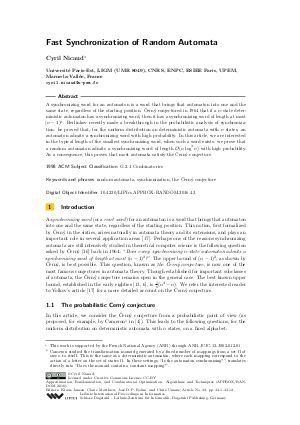Fast Synchronization of Random Automata
Author Cyril Nicaud
-
Part of:
Volume:
Approximation, Randomization, and Combinatorial Optimization. Algorithms and Techniques (APPROX/RANDOM 2016)
Part of: Series: Leibniz International Proceedings in Informatics (LIPIcs)
Part of: Conference: International Conference on Randomization and Computation (RANDOM)
Part of: Conference: International Conference on Approximation Algorithms for Combinatorial Optimization Problems (APPROX) - License:
 Creative Commons Attribution 3.0 Unported license
Creative Commons Attribution 3.0 Unported license
- Publication Date: 2016-09-06
File

PDF
LIPIcs.APPROX-RANDOM.2016.43.pdf
- Filesize: 0.55 MB
- 12 pages
Document Identifiers
Subject Classification
Keywords
- random automata
- synchronization
- the Černý conjecture
Metrics
- Access Statistics
-
Total Accesses (updated on a weekly basis)
0Document
0Metadata
Abstract
A synchronizing word for an automaton is a word that brings that automaton into one and the same state, regardless of the starting position. Cerny conjectured in 1964 that if a $n$-state deterministic automaton has a synchronizing word, then it has a synchronizing word of length at most (n-1)^2. Berlinkov recently made a breakthrough in the probabilistic analysis of synchronization: he proved that, for the uniform distribution on deterministic automata with n states, an automaton admits a synchronizing word with high probability. In this article, we are interested in the typical length of the smallest synchronizing word, when such a word exists: we prove that a random automaton admits a synchronizing word of length O(n log^{3}n) with high probability. As a consequence, this proves that most automata satisfy the Cerny conjecture.
Cite As Get BibTex
Cyril Nicaud. Fast Synchronization of Random Automata. In Approximation, Randomization, and Combinatorial Optimization. Algorithms and Techniques (APPROX/RANDOM 2016). Leibniz International Proceedings in Informatics (LIPIcs), Volume 60, pp. 43:1-43:12, Schloss Dagstuhl – Leibniz-Zentrum für Informatik (2016)
https://doi.org/10.4230/LIPIcs.APPROX-RANDOM.2016.43
BibTex
@InProceedings{nicaud:LIPIcs.APPROX-RANDOM.2016.43,
author = {Nicaud, Cyril},
title = {{Fast Synchronization of Random Automata}},
booktitle = {Approximation, Randomization, and Combinatorial Optimization. Algorithms and Techniques (APPROX/RANDOM 2016)},
pages = {43:1--43:12},
series = {Leibniz International Proceedings in Informatics (LIPIcs)},
ISBN = {978-3-95977-018-7},
ISSN = {1868-8969},
year = {2016},
volume = {60},
editor = {Jansen, Klaus and Mathieu, Claire and Rolim, Jos\'{e} D. P. and Umans, Chris},
publisher = {Schloss Dagstuhl -- Leibniz-Zentrum f{\"u}r Informatik},
address = {Dagstuhl, Germany},
URL = {https://drops.dagstuhl.de/entities/document/10.4230/LIPIcs.APPROX-RANDOM.2016.43},
URN = {urn:nbn:de:0030-drops-66665},
doi = {10.4230/LIPIcs.APPROX-RANDOM.2016.43},
annote = {Keywords: random automata, synchronization, the \v{C}ern\'{y} conjecture}
}
Author Details
References
-
David Aldous, Grégory Miermont, and Jim Pitman. Brownian bridge asymptotics for random p-mappings. Electron. J. Probab, 9:37-56, 2004.

- Mikhail V. Berlinkov. On the probability of being synchronizable. In Sathish Govindarajan and Anil Maheshwari, editors, Algorithms and Discrete Applied Mathematics - Second International Conference, CALDAM 2016, Thiruvananthapuram, India, February 18-20, 2016, Proceedings, volume 9602 of Lecture Notes in Computer Science, pages 73-84. Springer, 2016. URL: http://dx.doi.org/10.1007/978-3-319-29221-2_7.
- Mikhail V. Berlinkov and Marek Szykula. Algebraic synchronization criterion and computing reset words. In Giuseppe F. Italiano, Giovanni Pighizzini, and Donald Sannella, editors, Mathematical Foundations of Computer Science 2015 - 40th International Symposium, MFCS 2015, Milan, Italy, August 24-28, 2015, Proceedings, Part I, volume 9234 of Lecture Notes in Computer Science, pages 103-115. Springer, 2015. URL: http://dx.doi.org/10.1007/978-3-662-48057-1_8.
-
Peter J Cameron. Dixon’s theorem and random synchronization. Discrete Mathematics, 313(11):1233-1236, 2013.

-
Philippe Flajolet and Robert Sedgewick. Analytic Combinatorics. Cambridge University Press, 2009.

-
Peter Frankl. An extremal problem for two families of sets. Eur. J. Comb., 3:125-127, 1982.

-
Bernard Harris. Probability distributions related to random mappings. The Annals of Mathematical Statistics, 31(4):1045-1062, 1960.

- Richard M. Karp. The transitive closure of a random digraph. Random Struct. Algorithms, 1(1):73-94, 1990. URL: http://dx.doi.org/10.1002/rsa.3240010106.
- Andrzej Kisielewicz, Jakub Kowalski, and Marek Szykula. A fast algorithm finding the shortest reset words. In Ding-Zhu Du and Guochuan Zhang, editors, COCOON, volume 7936 of Lecture Notes in Computer Science, pages 182-196. Springer, 2013. URL: http://dx.doi.org/10.1007/978-3-642-38768-5_18.
-
Valentin F. Kolčin. Random Mappings: Translation Series in Mathematics and Engineering. Translations series in mathematics and engineering. Springer London, Limited, 1986.

- Cyril Nicaud. Random deterministic automata. In Erzsébet Csuhaj-Varjú, Martin Dietzfelbinger, and Zoltán Ésik, editors, Mathematical Foundations of Computer Science 2014 - 39th International Symposium, MFCS 2014, Budapest, Hungary, August 25-29, 2014. Proceedings, Part I, volume 8634 of Lecture Notes in Computer Science, pages 5-23. Springer, 2014. URL: http://dx.doi.org/10.1007/978-3-662-44522-8_2.
- Jörg Olschewski and Michael Ummels. The complexity of finding reset words in finite automata. In Petr Hlinený and Antonín Kucera, editors, MFCS, volume 6281 of Lecture Notes in Computer Science, pages 568-579. Springer, 2010. URL: http://dx.doi.org/10.1007/978-3-642-15155-2_50.
-
Jean-Eric Pin. On two combinatorial problems arising from automata thery. Annals of Discrete Mathematics, 17:535-548, 1983.

-
Jean-Jacques Quisquater and Joos Vandewalle, editors. Advances in Cryptology - EUROCRYPT'89, Workshop on the Theory and Application of of Cryptographic Techniques, Houthalen, Belgium, April 10-13, 1989, Proceedings, volume 434 of Lecture Notes in Computer Science. Springer, 1990.

-
Evgeny S. Skvortsov and Yulia Zaks. Synchronizing random automata. Discrete Mathematics & Theoretical Computer Science, 12(4):95-108, 2010.

-
J. Černý. Poznámka k. homogénnym experimentom s konecnymi automatmi. Matematicko-fyzikalny Časopis Slovensk, 14, 1964.

- Mikhail V. Volkov. Synchronizing Automata and the Cerny Conjecture. In Carlos Martín-Vide, Friedrich Otto, and Henning Fernau, editors, Language and Automata Theory and Applications, Second International Conference, LATA 2008, Tarragona, Spain, March 13-19, 2008. Revised Papers, volume 5196 of Lecture Notes in Computer Science, pages 11-27. Springer, 2008. URL: http://dx.doi.org/10.1007/978-3-540-88282-4_4.
-
Yulia Zaks and Evgeny S. Skvortsov. Synchronizing random automata on a 4-letter alphabet. Journal of Mathematical Sciences, 192:303-306, 2013.

